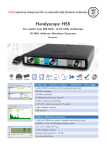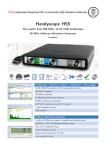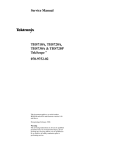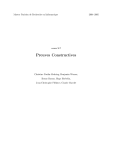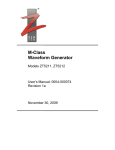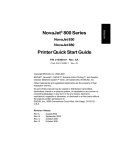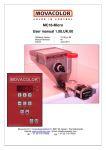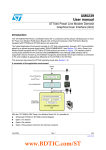Download Handyscope HS5 instrument manual
Transcript
Handyscope HS5 User manual TiePie engineering ATTENTION! Measuring directly on the line voltage can be very dangerous. The outside of the BNC connectors at the Handyscope HS5 are connected with the ground of the computer. Use a good isolation transformer or a differential probe when measuring at the line voltage or at grounded power supplies! A short-circuit current will flow if the ground of the Handyscope HS5 is connected to a positive voltage. This short-circuit current can damage both the Handyscope HS5 and the computer. c Copyright 2013 TiePie engineering. All rights reserved. Revision 2.8, November 2013 Despite the care taken for the compilation of this user manual, TiePie engineering can not be held responsible for any damage resulting from errors that may appear in this manual. Contents 1 Safety 1 2 Declaration of conformity 3 3 Introduction 3.1 Sampling . . . . . . 3.2 Sample frequency . . 3.2.1 Aliasing . . . 3.3 Digitizing . . . . . . 3.4 Signal coupling . . . 3.5 Probe compensation . . . . . . . . . . . . . . . . . . . . . . . . . . . . . . . . . . . . . . . . . . . . . . . . . . . . . . . . . . . . . . . . . . . . . . . . . . . . . . . . . . . . . . . . . . . . . . . . . . . . . . 5 . 7 . 8 . 8 . 10 . 11 . 11 4 Driver installation 13 4.1 Introduction . . . . . . . . . . . . . . . . . . . . . . . 13 4.2 Where to find the driver setup . . . . . . . . . . . . 13 4.3 Executing the installation utility . . . . . . . . . . . 13 5 Hardware installation 5.1 Power the instrument . . . . . . . . . . 5.1.1 External power . . . . . . . . . . 5.2 Connect the instrument to the computer 5.2.1 Found New Hardware Wizard . . 5.3 Plug into a different USB port . . . . . 5.4 Operating conditions . . . . . . . . . . . . . . . . . . . . . . . . . . . . . . . . . . . . . . . . . . . . . . . . . . . . . 19 19 19 20 20 21 21 6 Combining instruments 23 7 Front panel 7.1 CH1 and CH2 input connectors . . . . . . . . . . . . 7.2 AWG output connector . . . . . . . . . . . . . . . . 7.3 Power indicator . . . . . . . . . . . . . . . . . . . . . 25 25 25 25 8 Rear panel 8.1 Power . . . . . . . . . . 8.1.1 Power adapter . 8.1.2 USB power cable 8.2 USB . . . . . . . . . . . 8.3 Extension Connector . . 27 27 28 28 29 29 . . . . . . . . . . . . . . . . . . . . . . . . . . . . . . . . . . . . . . . . . . . . . . . . . . . . . . . . . . . . . . . . . . . . . . Contents . . . . . . . . . . I 8.4 AUX I/O . . . . . . . . . . . . . . . . . . . . . . . . 30 9 Specifications 9.1 Acquisition system . . . . . . . 9.2 Acquisition system (continued) 9.3 Trigger system . . . . . . . . . 9.4 Arbitrary Waveform Generator 9.5 Power . . . . . . . . . . . . . . 9.6 Probes . . . . . . . . . . . . . . 9.7 Physical . . . . . . . . . . . . . 9.8 I/O connectors . . . . . . . . . 9.9 Interface . . . . . . . . . . . . . 9.10 System requirements . . . . . . 9.11 Environmental conditions . . . 9.12 Certifications and Compliances 9.13 Package contents . . . . . . . . II . . . . . . . . . . . . . . . . . . . . . . . . . . . . . . . . . . . . . . . . . . . . . . . . . . . . . . . . . . . . . . . . . . . . . . . . . . . . . . . . . . . . . . . . . . . . . . . . . . . . . . . . . . . . . . . . . . . . . . . . . . . . . . . . . . . . . . . . . . . . . . . . . . . . . . . . . . . . 31 31 32 32 33 35 36 36 36 36 37 37 37 37 Safety 1 When working with electricity, no instrument can guarantee complete safety. It is the responsibility of the person who works with the instrument to operate it in a save way. Maximum security is achieved by selecting the proper instruments and following save working procedures. Save working tips are given below: • Always work according (local) regulations. • Work on installations with voltages higher than 25 VAC or 60 VDC should only be performed by qualified personnel. • Avoid working alone. • Observe all indications on the Handyscope HS5 before connecting any wiring • Check the probes/test leads for damages. Do not use them if they are damaged • Take care when measuring at voltages higher than 25 VAC or 60 VDC . • Do not operate the equipment in an explosive atmosphere or in the presence of flammable gases or fumes. • Do not use the equipment if it does not operate properly. Have the equipment inspected by qualified service personal. If necessary, return the equipment to TiePie engineering for service and repair to ensure that safety features are maintained. • Measuring directly on the line voltage can be very dangerous. The outside of the BNC connectors at the Handyscope HS5 are connected with the ground of the computer. Use a good isolation transformer or a differential probe when measuring at the line voltage or at grounded power supplies! A short-circuit current will flow if the ground of the Handyscope HS5 is connected to a positive voltage. This short-circuit current can damage both the Handyscope HS5 and the computer. Safety 1 2 Chapter 1 Declaration of conformity 2 TiePie engineering Koperslagersstraat 37 8601 WL Sneek The Netherlands EC Declaration of conformity We declare, on our own responsibility, that the product Handyscope Handyscope Handyscope Handyscope Handyscope Handyscope Handyscope Handyscope HS5-530 HS5-530XM HS5-220 HS5-220XM HS5-110 HS5-110XM HS5-055 HS5-055XM for which this declaration is valid, is in compliance with EN 55011:2009/A1:2010 EN 55022:2006/A1:2007 IEC 61000-6-1/EN 61000-6-1:2007 IEC 61000-6-1/EN 61000-6-1:2007 according the conditions of the EMC standard 2004/108/EC and also with Canada: ICES-001:2004 Australia/New Zealand: AS/NZS Sneek, 29-5-2012 ir. A.P.W.M. Poelsma Declaration of conformity 3 Environmental considerations This section provides information about the environmental impact of the Handyscope HS5. Handyscope HS5 end-of-life handling Production of the Handyscope HS5 required the extraction and use of natural resources. The equipment may contain substances that could be harmful to the environment or human health if improperly handled at the Handyscope HS5’s end of life. In order to avoid release of such substances into the environment and to reduce the use of natural resources, recycle the Handyscope HS5 in an appropriate system that will ensure that most of the materials are reused or recycled appropriately. The symbol shown below indicates that the Handyscope HS5 complies with the European Union’s requirements according to Directive 2002/96/EC on waste electrical and electronic equipment (WEEE). Restriction of Hazardous Substances The Handyscope HS5 has been classified as Monitoring and Control equipment, and is outside the scope of the 2002/95/EC RoHS Directive. 4 Chapter 2 3 Introduction Before using the Handyscope HS5 first read chapter 1 about safety. Many technicians investigate electrical signals. Though the measurement may not be electrical, the physical variable is often converted to an electrical signal, with a special transducer. Common transducers are accelerometers, pressure probes, current clamps and temperature probes. The advantages of converting the physical parameters to electrical signals are large, since many instruments for examining electrical signals are available. The Handyscope HS5 is a portable two channel measuring instrument with Arbitrary Waveform Generator. The Handyscope HS5 is available in several models with different maximum sampling frequencies: 50 MS/s, 100 MS/s, 200 MS/s or 500 MS/s. The native resolutions are 12 bits and 14 bits and a user selectable resolution of 16 bits is available too, with adjusted maximum sampling frequencies: resolution 12 bit 14 bit 16 bit channels model 530 model 220 model 110 model 055 CH1 500 MS/s 200 MS/s 100 MS/s 50 MS/s CH1+CH2 200 MS/s 100 MS/s 50 MS/s 20 MS/s 100 MS/s 50 MS/s 20 MS/s 10 MS/s 6.25 MS/s 3.125 MS/s 1.25 MS/s 625 kS/s CH1 CH1+CH2 CH1 CH1+CH2 Table 3.1: Maximum sampling frequencies The Handyscope HS5 supports high speed continuous streaming measurements. The maximum streaming rates are: Introduction 5 resolution 12 bit 14 bit 16 bit channels model 530 model 220 model 110 model 055 CH1 20 MS/s 10 MS/s 5 MS/s 2 MS/s CH1+CH2 10 MS/s 5 MS/s 2 MS/s 1 MS/s CH1 20 MS/s 10 MS/s 5 MS/s 2 MS/s CH1+CH2 10 MS/s 5 MS/s 2 MS/s 1 MS/s 6.25 MS/s 3.125 MS/s 1.25 MS/s 625 kS/s CH1 CH1+CH2 Table 3.2: Maximum streaming rates The Handyscope HS5 is available with two memory configurations, these are: memory model 530 model 220 model 110 model 055 standard model 128 KiS 128 KiS 128 KiS 128 KiS option XM 32 MiS 32 MiS 32 MiS 32 MiS Table 3.3: Maximum record lengths per channel Optionally available for the Handyscope HS5 are SureConnect connection test and resistance measurement. SureConnect connection test tells you immediately whether your test probe or clip actually makes electrical contact or not. No more doubt whether your probe doesn’t make contact or there really is no signal. This is useful when surfaces are oxidized and your probe cannot get a good electrical contact. Simply activate the SureConnect and you know whether there is contact or not. Also when back probing connectors in confined places, SureConnect immediately shows whether the probes make contact or not. Models of the Handyscope HS5 with SureConnect come with resistance measurement on all channels. Resistances up to 2 MOhm can be measured directly. Resistance can be shown in meter displays and can also be plotted versus time in a graph, creating an Ohm scope. With the accompanying software the Handyscope HS5 can be used as an oscilloscope, a spectrum analyzer, a true RMS voltmeter or a transient recorder. All instruments measure by sampling the input signals, digitizing the values, process them, save them and display them. 6 Chapter 3 3.1 Sampling When sampling the input signal, samples are taken at fixed intervals. At these intervals, the size of the input signal is converted to a number. The accuracy of this number depends on the resolution of the instrument. The higher the resolution, the smaller the voltage steps in which the input range of the instrument is divided. The acquired numbers can be used for various purposes, e.g. to create a graph. Figure 3.1: Sampling The sine wave in figure 3.1 is sampled at the dot positions. By connecting the adjacent samples, the original signal can be reconstructed from the samples. You can see the result in figure 3.2. Figure 3.2: ”connecting” the samples Introduction 7 3.2 Sample frequency The rate at which the samples are taken is called the sampling frequency, the number of samples per second. A higher sampling frequency corresponds to a shorter interval between the samples. As is visible in figure 3.3, with a higher sampling frequency, the original signal can be reconstructed much better from the measured samples. Figure 3.3: The effect of the sampling frequency The sampling frequency must be higher than 2 times the highest frequency in the input signal. This is called the Nyquist frequency. Theoretically it is possible to reconstruct the input signal with more than 2 samples per period. In practice, 10 to 20 samples per period are recommended to be able to examine the signal thoroughly. 3.2.1 Aliasing When sampling an analog signal with a certain sampling frequency, signals appear in the output with frequencies equal to the sum and difference of the signal frequency and multiples of the sampling frequency. For example, when the sampling frequency is 1000 Hz and the signal frequency is 1250 Hz, the following signal frequencies will be present in the output data: 8 Chapter 3 Multiple of sampling frequency 1250 Hz signal -1250 Hz signal -1000 -1000 + 1250 = 250 -1000 - 1250 = -2250 0 0 + 1250 = 1250 1000 1000 + 1250 = 2250 1000 - 1250 = -250 2000 2000 + 1250 = 3250 2000 - 1250 = 750 ... 0 - 1250 = -1250 ... Table 3.4: Aliasing As stated before, when sampling a signal, only frequencies lower than half the sampling frequency can be reconstructed. In this case the sampling frequency is 1000 Hz, so we can we only observe signals with a frequency ranging from 0 to 500 Hz. This means that from the resulting frequencies in the table, we can only see the 250 Hz signal in the sampled data. This signal is called an alias of the original signal. If the sampling frequency is lower than twice the frequency of the input signal, aliasing will occur. The following illustration shows what happens. Figure 3.4: Aliasing In figure 3.4, the green input signal (top) is a triangular signal with a frequency of 1.25 kHz. The signal is sampled with a frequency of 1 kHz. The corresponding sampling interval is 1/1000Hz Introduction 9 = 1ms. The positions at which the signal is sampled are depicted with the blue dots. The red dotted signal (bottom) is the result of the reconstruction. The period time of this triangular signal appears to be 4 ms, which corresponds to an apparent frequency (alias) of 250 Hz (1.25 kHz - 1 kHz). To avoid aliasing, always start measuring at the highest sampling frequency and lower the sampling frequency if required. 3.3 Digitizing When digitizing the samples, the voltage at each sample time is converted to a number. This is done by comparing the voltage with a number of levels. The resulting number is the number corresponding to the level that is closest to the voltage. The number of levels is determined by the resolution, according to the following relation: LevelCount = 2Resolution . The higher the resolution, the more levels are available and the more accurate the input signal can be reconstructed. In figure 3.5, the same signal is digitized, using two different amounts of levels: 16 (4-bit) and 64 (6-bit). Figure 3.5: The effect of the resolution The Handyscope HS5 measures at e.g. 14 bit resolution (214 =16384 levels). The smallest detectable voltage step depends on the input 10 Chapter 3 range. This voltage can be calculated as: V oltageStep = F ullInputRange/LevelCount For example, the 200 mV range ranges from -200 mV to +200 mV, therefore the full range is 400 mV. This results in a smallest detectable voltage step of 0.400V/16384 = 24.41 µV. 3.4 Signal coupling The Handyscope HS5 has two different settings for the signal coupling: AC and DC. In the setting DC, the signal is directly coupled to the input circuit. All signal components available in the input signal will arrive at the input circuit and will be measured. In the setting AC, a capacitor will be placed between the input connector and the input circuit. This capacitor will block all DC components of the input signal and let all AC components pass through. This can be used to remove a large DC component of the input signal, to be able to measure a small AC component at high resolution. When measuring DC signals, make sure to set the signal coupling of the input to DC. 3.5 Probe compensation The Handyscope HS5 is shipped with a probe for each input channel. These are 1x/10x selectable passive probes. This means that the input signal is passed through directly or 10 times attenuated. When using an oscilloscope probe in 1:1 the setting, the bandwidth of the probe is only 6 MHz. The full bandwidth of the probe is only obtained in the 1:10 setting The x10 attenuation is achieved by means of an attenuation network. This attenuation network has to be adjusted to the oscilloscope input circuitry, to guarantee frequency independency. This Introduction 11 is called the low frequency compensation. Each time a probe is used on an other channel or an other oscilloscope, the probe must be adjusted. Therefore the probe is equiped with a setscrew, with which the parallel capacity of the attenuation network can be altered. To adjust the probe, switch the probe to the x10 and attach the probe to a 1 kHz square wave signal. Then adjust the probe for a square front corner on the square wave displayed. See also the following illustrations. Figure 3.6: correct Figure 3.7: under compensated Figure 3.8: over compensated 12 Chapter 3 4 Driver installation Before connecting the Handyscope HS5 to the computer, the drivers need to be installed. 4.1 Introduction To operate a Handyscope HS5, a driver is required to interface between the measurement software and the instrument. This driver takes care of the low level communication between the computer and the instrument, through USB. When the driver is not installed, or an old, no longer compatible version of the driver is installed, the software will not be able to operate the Handyscope HS5 properly or even detect it at all. The installation of the USB driver is done in a few steps. Firstly, the driver has to be pre-installed by the driver setup program. This makes sure that all required files are located where Windows can find them. When the instrument is plugged in, Windows will detect new hardware and install the required drivers. 4.2 Where to find the driver setup The driver setup program and measurement software can be found in the download section on TiePie engineering’s website and on the CD-ROM that came with the instrument. It is recommended to install the latest version of the software and USB driver from the website. This will guarantee the latest features are included. 4.3 Executing the installation utility To start the driver installation, execute the downloaded driver setup program, or the one on the CD-ROM that came with the instrument. The driver install utility can be used for a first time Driver installation 13 installation of a driver on a system and also to update an existing driver. The screen shots in this description may differ from the ones displayed on your computer, depending on the Windows version. Figure 4.1: Driver install: step 1 When drivers were already installed, the install utility will remove them before installing the new driver. To remove the old driver successfully, it is essential that the Handyscope HS5 is disconnected from the computer prior to starting the driver install utility. When the Handyscope HS5 is used with an external power supply, this must be disconnected too. 14 Chapter 4 Figure 4.2: Driver install: step 2 When the instrument is still connected, the driver install utility will recognize it and report this. You will be asked to continue anyway. Figure 4.3: Driver install: Instrument is still connected Clicking ”No” will bring back the previous screen. The instrument should now be disconnected. Then the removal of the existing driver can be continued by clicking ”Next”. Clicking ”Yes” will ignore the fact that the instrument is still connected and continue removal of the old driver. This option is not recommended, as removal may fail, after which installation of the new driver may fail as well. When no existing driver was found or the existing driver is removed, the location for the pre-installation of the new driver can be selected. Driver installation 15 Figure 4.4: Driver install: step 3 On Windows XP, the installation may inform about the drivers not being ”Windows Logo Tested”. The driver is not causing any danger for your system and can be safely installed. Please ignore this warning and continue the installation. Figure 4.5: Driver install: step 4 16 Chapter 4 The driver install utility now has enough information and can install the drivers. Clicking ”Install” will remove existing drivers and install the new driver. A remove entry for the new driver is added to the software applet in the Windows control panel. Figure 4.6: Driver install: step 5 Figure 4.7: Driver install: Finished Driver installation 17 18 Chapter 4 Hardware installation 5 Drivers have to be installed before the Handyscope HS5 is connected to the computer for the first time. See chapter 4 for more information. 5.1 Power the instrument The Handyscope HS5 is powered by the USB, no external power supply is required. Only connect the Handyscope HS5 to a bus powered USB port, otherwise it may not get enough power to operate properly. 5.1.1 External power In certain cases, the Handyscope HS5 cannot get enough power from the USB port. When a Handyscope HS5 is connected to a USB port, powering the hardware will result in an inrush current higher than the nominal current. After the inrush current, the current will stabilize at the nominal current. USB ports have a maximum limit for both the inrush current peak and the nominal current. When either of them is exceeded, the USB port will be switched off. As a result, the connection to the Handyscope HS5 will be lost. Most USB ports can supply enough current for the Handyscope HS5 to work without an external power supply, but this is not always the case. Some (battery operated) portable computers or (bus powered) USB hubs do not supply enough current. The exact value at which the power is switched off, varies per USB controller, so it is possible that the Handyscope HS5 functions properly on one computer, but does not on another. The Handyscope HS5 comes with a universal power supply, that can be connected to a power outlet using the appropriate adapter. The 3.5 mm connector attached to the power supply must be plugged into the power connector at the rear of the Handyscope Hardware installation 19 HS5. Refer to paragraph 8.1 for specifications of the external power intput. When the Arbitrary Waveform Generator is used, the power that the Handyscope HS5 requires may strongly increase. It is recommended to use the external power supply when the Handyscope HS5 Arbitrary Waveform Generator is used. 5.2 Connect the instrument to the computer After the new driver has been pre-installed (see chapter 4), the Handyscope HS5 can be connected to the computer. When the Handyscope HS5 is connected to a USB port of the computer, Windows will report new hardware. The Found New Hardware Wizard will appear. Depending on the Windows version, the New Hardware Wizard will show a number of screens in which it will ask for information regarding the drivers of the newly found hardware. The appearance of the dialogs will differ for each Windows version and might be different on the computer where the Handyscope HS5 is installed. The driver consists of two parts which are installed separately. Once the first part is installed, the installation of the second part will start automatically. Installation of the second part is identical to the first part, therefore they are not described individually here. 5.2.1 Found New Hardware Wizard Figure 5.1: Hardware install: step 1 Windows has detected new hardware and starts installing the drivers. 20 Chapter 5 Figure 5.2: Hardware install: step 2 Once ready, Windows will report that the driver is installed. Figure 5.3: Hardware install: step 3 Now the driver is installed, the measurement software can be installed and the Handyscope HS5 can be used. 5.3 Plug into a different USB port When the Handyscope HS5 is plugged into a different USB port, some Windows versions will treat the Handyscope HS5 as different hardware and will ask to install the drivers again. This is controlled by Microsoft Windows and is not caused by TiePie engineering. 5.4 Operating conditions The Handyscope HS5 is ready for use as soon as the software is started. However, to achieve rated accuracy, allow the instrument to settle for 20 minutes. If the instrument has been subjected to extreme temperatures, allow additional time for internal temperatures to stabilize. Because of temperature compensated calibration, the Handyscope HS5 will settle within specified accuracy regardless of the surrounding temperature. Hardware installation 21 22 Chapter 5 Combining instruments 6 When more channels are required than one instrument can offer, multiple instruments can be combined into a larger combined instrument. To combine two or more instruments, the instruments need to be connected to each other using special cables. The Handyscope HS5 has an advanced clock distribution system, making it very easy to connect multiple instruments to each other to create a large multi channel instrument that uses a shared sampling clock and shared trigger signals. Figure 6.1: Auxilary I/O connectors Connecting is done by daisy chaining the auxiliary I/O connectors of the instruments prior to starting the software, using a special coupling cable (order number TP-C50H). The software will detect how the instruments are connected to each other and will automatically terminate the connection bus. The software will combine the connected instruments to one large instrument. The combined instruments will now sample using the same clock, with a deviation of 0 ppm. Figure 6.2: 3 Handyscope HS5’s combined A six channel instrument is easily made by connecting three Handyscope HS5’s to each other. Combining instruments 23 24 Chapter 6 7 Front panel Figure 7.1: Front panel 7.1 CH1 and CH2 input connectors The CH1 and CH2 BNC connectors are the main inputs of the acquisition system. The outside of the BNC connectors is connected to the ground of the Handyscope HS5. Connecting the outside of the BNC connector to a potential other than ground will result in a short circuit that may damage the device under test, the Handyscope HS5 and the computer. 7.2 AWG output connector The AWG BNC connector is the output of the internal Arbitrary Waveform Generator. The outside of this BNC connector is connected to the ground of the Handyscope HS5. 7.3 Power indicator A power indicator is situated at the top cover of the instrument. It is lit when the Handyscope HS5 is powered. Front panel 25 26 Chapter 7 8 Rear panel Figure 8.1: Rear panel 8.1 Power The Handyscope HS5 is powered through the USB. If the USB cannot supply enough power, it is possible to power the instrument externally. The Handyscope HS5 has two external power inputs located at the rear of the instrument: the dedicated power connector and a pin of the 9 pin D-sub extension connector. The specifications of the dedicated power connector are: Pin Center pin Outside bushing Dimension Ø1.3 mm Ø3.5 mm Description positive ground Figure 8.2: Power connector To power the instrument through the extension connector, the power has to be applied to pin 7 of the extension connector. Pin 6 can be used as ground. The following minimum and maximum voltages apply to the power inputs: Minimum 4.5 VDC / 2 A max. Maximum 15 VDC / 1 A max. Table 8.1: Maximum voltages Rear panel 27 Note that the externally applied voltage should be higher than the USB voltage to relieve the USB port. 8.1.1 Power adapter The Handyscope HS5 comes with an external power adapter that can be connected to any mains power net that supplies 100 – 240 VAC , 50 – 60 Hz. The external power adapter can be connected to the dedicated power connector. Figure 8.3: Power adapter 8.1.2 USB power cable A special USB external power cable is supplied with the Handyscope HS5 that can be used instead of a power adapter. One end of this cable can be connected to a second USB port on the computer, the other end can be plugged in the dedicated power connector at the rear of the instrument. The power for the instrument will then be taken from two USB ports. Figure 8.4: USB power cable 28 Chapter 8 8.2 USB The Handyscope HS5 is equipped with a USB 2.0 High speed (480 Mbit/s) interface with a fixed cable with type A plug. It will also work on a computer with a USB 1.1 interface, but will then operate at 12 Mbit/s. 8.3 Extension Connector Figure 8.5: Extension connector A 9 pin female D-sub connector is available at the back of the Handyscope HS5 containing the following signals: Pin Description Pin Description 1 2 EXT 1 (LVTTL) EXT 2 (LVTTL) 6 7 GND Power IN 3 4 5 EXT 3 (LVTTL) I2 C SDA I2 C SCL 8 9 Power OUT (see description) reserved Table 8.2: Pin description Extension connector Pins EXT 1, EXT 2 and EXT 3 are equipped with internal 1 kOhm pull-up resistors to 2.5 V. These pins can simultaneously be used as inputs and outputs. Each pin can be configured as external digital trigger input for the acquisition system and/or the generator of the Handyscope HS5. Also, each pin can be configured to output one of the following function generator outputs: • Generator start • Generator stop • Generator new period The I2 C pins are equipped with internal 2.2 kOhm pull-up resistors connected to 3 V. Rear panel 29 Pin 8, Power OUT, has the same potential as the Handyscope HS5 power supply. When the Handyscope HS5 is USB powered, it is at USB power level. When the Handyscope HS5 is externally powered, it is at the same level as the external power input. 8.4 AUX I/O The Handyscope HS5 has two Auxiliary I/O connectors at the rear of the instrument. These can be used to combine multiple instruments to a single combined instrument to perform synchronized measurements. Figure 8.6: Auxiliary I/O connector Pin Description Pin Description 1 2 GND EXT CLK P (LVDS) 11 12 Data OK P EXT (LVDS) Data OK N EXT (LVDS) 3 4 5 6 7 8 EXT CLK N (LVDS) GND Data OK (I/O) reserved GND Ext Trigger (I/O) 13 14 15 16 17 18 reserved Generator Trigger (I/O) reserved reserved GND reserved reserved GND 19 GND 9 10 Table 8.3: Pin description Auxiliary I/O connector The I/O signals (pins 5, 8 and 14) can be used as input and output. They are digital signals switching between 0 V and 2.5 V. The LVDS external clock (pins 2 and 3) must be 10 MHz, ±1%. The Auxiliary I/O connectors use HDMI type C sockets, but are not HDMI compliant. They can not be used to connect an HDMI device to the Handyscope HS5. 30 Chapter 8 9 Specifications To achieve rated accuracy, allow the instrument to settle for 20 minutes. When subjected to extreme temperatures, allow additional time for internal temperatures to stabilize. Because of temperature compensated calibration, the Handyscope HS5 will settle within specified accuracy regardless of the surrounding temperature. 9.1 Acquisition system Number of input channels 2 analog CH1, CH2 BNC Type Single ended Resolution 12, 14, 16 bit user selectable Accuracy 0.25% ± 1 LSB of full scale Range ±200 mV to ±80 V full scale Coupling AC/DC Impedance 1 MΩ / 25 pF Maximum voltage 200 V (DC + AC peak <10 kHz) Maximum voltage 1:10 probe 600 V (DC + AC peak <10 kHz) Bandwidth (-3dB) at 75% of full scale input Ch1 250 MHz Ch2 100 MHz AC coupling cut off freq. (-3dB) ±1.5 Hz SureConnect Optionally available (option S) Maximum voltage on connection 200 V (DC + AC peak <10 kHz) Resistance measurement Optionally available (option S) Ranges 100 Ohm to 2 MOhm full scale Accuracy 3% Response time (to 95%) <5 ms Specifications 31 9.2 Acquisition system (continued) Maximum sampling rate 12 bit, measuring one channel 12 bit, measuring two channels 14 bit 16 bit Maximum streaming rate 12/14 bit, measuring one channel 12/14 bit, measuring two channels 16 bit Sampling source Internal Accuracy Stability Time base aging External Input range Memory Standard model XM option Depending on model 500 MS/s, 200 MS/s, 100 MS/s or 50 MS/s 200 MS/s, 100 MS/s, 50 MS/s or 20 MS/s 100 MS/s, 50 MS/s, 20 MS/s or 10 MS/s 6.25 MS/s, 3.125 MS/s, 1.25 MS/s or 625 kS/s Depending on model 20 MS/s, 10 MS/s, 5 MS/s or 2 MS/s 10 MS/s, 5 MS/s, 2 MS/s or 1 MS/s 6.25 MS/s, 3.125 MS/s, 1.25 MS/s or 625 kS/s TCXO ±0.0001% ±1 ppm over 0 ◦ C to +55 ◦ C ±1 ppm per year time base aging LVDS, on auxilary connectors 10 MHz 128 KiSamples per channel 32 MSamples per channel 64 MSamples when measuring CH1 at 500 MS/s 9.3 Trigger system System Source Trigger modes Level adjustment Hysteresis adjustment Resolution Pre trigger Post trigger Digital external trigger Input Range Coupling Jitter Source = channel Source = external or generator Sample frequency = 500 MS/s Sample frequency < 500 MS/s 32 Chapter 9 Digital, 2 levels CH1, CH2, digital external, OR, generator start, generator new period, generator stop Rising edge, falling edge, any edge, inside window, outside window, drop inside window, drop outside window, pulse width 0 to 100% of full scale 0 to 100% of full scale 0.024 % (12 bits)/0.006 % (14/16 bits) 0 to 32 MSamples, 1 sample resolution) 0 to 32 MSamples, 1 sample resolution) Auxilary I/O connector 0 to 2.5 V (TTL) DC Depending on source and sample frequency ≤ 1 sample ≤ 8 samples ≤ 4 samples 9.4 Arbitrary Waveform Generator Output channel DAC resolution Output range Amplitude Range Resolution Accuracy DC offset Range Resolution Accuracy Noise level 0.12 V 1.2 V 12 V Coupling Impedance Overload protection System Memory Standard model XM option Operating modes Sampling rate Sampling source Accuracy Stability Time base aging Waveforms Standard Built-in arbitrary 1 analog, BNC 14 bit @ 240 MS/s -12 to +12 V (open circuit) 0.12 V, 1.2 V, 12 V (open circuit) 12 bit 0.4% of range -12 V to +12 V (open circuit) 12 bit 0.4% of range 900 µVRMS 1.3 mVRMS 1.5 mVRMS DC 50 Ω Output turns off when overload is applied. Instrument will tolerate a short circuit to ground indefinitely. Trueform CDS 256 KiSamples 64 MiSamples Continuous, triggered, gated 240 MS/s, 200 MS/s, 100 MS/s or 50 MS/s, depending on model Internal TCXO 0.0001 % ±1 ppm over 0 ◦ C to +55 ◦ C ±1 ppm per year Sine, square, triangle, pulse, noise, DC Exponential Rise and Fall, Sin(x)/x, Cardiac, Haversine, Lorentz, D-Lorentz Specifications 33 Arbitrary Waveform Generator - continued Signal characteristics Sine Frequency range Amplitude flattness <100 kHz <5 MHz <20 MHz <30 MHz Spurious <100 kHz 100 kHz to 1 MHz 1 MHz to 10 MHz 10 MHz to 15 MHz 15 MHz to 20 MHz 20 MHz to 30 MHz Square Frequency range Rise/fall time Overshoot Variable duty cycle Asymmetry Jitter (RMS) Triangle Frequency range Nonlinearity (of peak output) Symmetry Pulse Period Pulse width Variable edge time Overshoot Jitter (RMS) Noise Bandwidth (typical) Arbitrary Frequency range Length Sample rate model HS5-530 model HS5-220 model HS5-110 model HS5-055 Rise/fall time Nonlinearity (of peak output) Settling time Jitter (RMS) 34 Chapter 9 1 µHz to 5, 10, 20 or 30 MHz, depending on model Relative to 1 kHz ±0.1 dB ±0.15 dB ±0.3 dB ±0.4 dB -75 -70 -60 -55 -45 -35 dBc dBc dBc dBc dBc dBc 1 µHz to 5, 10, 20 or 30 MHz, depending on model <8 ns <1% 0.01 % to 99.99 % <0 % of period + 5 ns (@ 50% duty cycle) <50 ps 1 µHz to 5, 10, 20 or 30 MHz, depending on model <0.01 % 0 % to 100 %, 0.1% steps 100 ns to 1000 s 15 ns to 1000 s 20 ns to 1 s <1 % <50 ps 30 MHz 1 µHz to 5, 10, 20 or 30 MHz, depending on model 1 to 64 MiSamples 240 MS/s 200 MS/s 100 MS/s 50 MS/s <8 ns <0.01 % <8 ns to 10 % final value <50 ps Arbitrary Waveform Generator - continued Burst Waveforms Count Trigger Sweep Waveforms Type Count Trigger Modulation AM Carrier waveforms Modulating waveforms Modulating frequency Depth Source FM Carrier waveforms Modulating waveforms Modulating frequency Peak deviation Source FSK Carrier waveforms Modulating waveforms Modulating frequency Peak deviation Source Sine, square, triangle, noise, arbitrary 1 to 65535 Software, external Available only on models with extended memory option XM Sine, square, triangle, noise, arbitrary Linear, logarithmic Up, down Software, external Sine, square, triangle, arbitrary Sine, square, triangle, noise, arbitrary 2 mHz to 20 MHz 0.0% to 100% Internal Sine, square, triangle, arbitrary Sine, square, triangle, noise, arbitrary 2 mHz to 20 MHz DC to 20MHz Internal Sine, square, triangle, arbitrary 50% duty cycle square 2 mHz to 20 MHz 1 µHz to 20MHz Internal 9.5 Power Power Consumption Power adapter Input Output Dimension Height Width Length Order number Replaceable mains plugs for From USB or external input 5 VDC , 500 mA max External 110 to 240 VAC , 50 to 60 Hz 0.85 A Max., 50 VA to 80 VA 5.5 VDC , 2 A 30 mm / 1.2” 45 mm / 1.8” 75 mm / 3” TP-UE15WCP1-055200SPA EU, US, AU, UK Specifications 35 9.6 Probes Model Bandwidth 1:1 1:10 Rise time 1:1 1:10 Input impedance 1:1 1:10 Input capacitance 1:1 1:10 Compensation range 1:1 1:10 Working voltage 1:1 1:10 HP-9250 6 MHz 250 MHz 58 ns 1.4 ns 1 MΩ (oscilloscope impedance) 10 MΩ (incl. 1 MΩ oscilloscope impedance) 47 pF + oscilloscope capacitance 17 pF 10 to 35 pF 300 V CAT I, 150 V CAT II (DC + peak AC) 600 V CAT I, 300 V CAT II (DC + peak AC) 9.7 Physical Height Length Width Weight USB cord length 25 mm / 1.0” 170 mm / 6.7” 140 mm / 5.2” 430 g / 15 ounce 1.8 m / 70” 9.8 I/O connectors CH1, CH2 AWG USB Extension connector Power Auxiliary I/O connectors 1–2 BNC BNC Fixed cable with USB type A plug, 1.8 m D-sub 9 pins female 3.5 mm power socket HDMI type C socket 9.9 Interface Interface 36 Chapter 9 USB 2.0 High Speed (480 Mbit/s) (USB 1.1 Full Speed (12 Mbit/s) compatible) 9.10 System requirements PC I/O connection Operating System USB 1.1, USB 2.0 or newer Windows 2000/XP/Vista/7/8 32 and 64 bits 9.11 Environmental conditions Operating Ambient temperature Relative humidity Storage Ambient temperature Relative humidity 0 ◦ C to 55 ◦ C 10 to 90% non condensing -20 ◦ C to 70 ◦ C 5 to 95% non condensing 9.12 Certifications and Compliances CE mark compliance RoHS EN 55011:2009/A1:2010 EN 55022:2006/A1:2007 IEC 61000-6-1/EN 61000-6-1:2007 IEC 61000-6-1/EN 61000-6-1:2007 Canada: ICES-001:2004 Australia/New Zealand: AS/NZS Yes Yes Yes Yes Yes Yes Yes Yes 9.13 Package contents Instrument Probes Accessories Software Drivers Manual Handyscope HS5 2 x 1:1 / 1:10 switchable, HP-9250 External power adapter USB power cable Windows 2000/XP/Vista/7/8 Windows 2000/XP/Vista/7/8 Instrument manual and software user’s manual Specifications 37 38 Chapter 9 If you have any suggestions and/or remarks regarding this manual, please contact: @ TiePie engineering P.O. Box 290 8600 AG SNEEK The Netherlands @ TiePie engineering Koperslagersstraaat 37 8601 WL SNEEK The Netherlands Tel.: Fax: E-mail: Site: +31 515 415 416 +31 515 418 819 [email protected] www.tiepie.nl












































